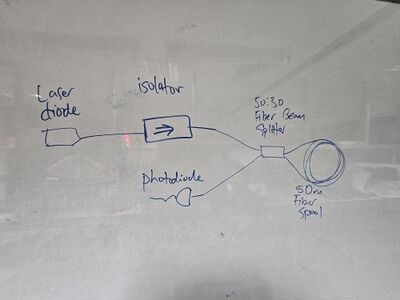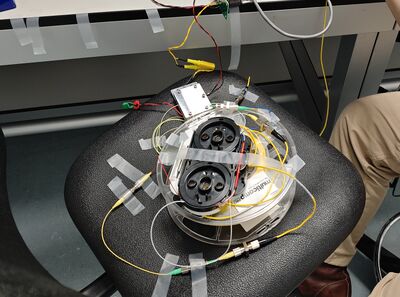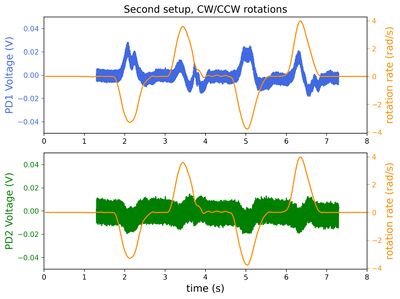Laser Gyroscope: Difference between revisions
| Line 77: | Line 77: | ||
==2nd setup== | ==2nd setup== | ||
18 March | 18 March | ||
[[File:SecondSetup_picture.jpeg|400px]] | |||
Instead of further investigation, moved all components onto an optical breadboard. All fibers are taped down to the breadboard with only 2 fibers untaped. 1 from the 1550nm laser diode and the other leading to the photodiode. With this new setup, we seem to get the expected behaviour? A voltage change from the photodiode is only observed when the fiber coil is moving and returns to its original value when its stationary. | Instead of further investigation, moved all components onto an optical breadboard. All fibers are taped down to the breadboard with only 2 fibers untaped. 1 from the 1550nm laser diode and the other leading to the photodiode. With this new setup, we seem to get the expected behaviour? A voltage change from the photodiode is only observed when the fiber coil is moving and returns to its original value when its stationary. | ||
In order to verify the rotation rate of the fiber coil, we placed a phone with a gyroscope readout enabled (phyphox). We then turn the chair clockwise and counter-clockwise continuously, and plot the results below: | |||
[[File:SecondSetup_CWCCW.jpeg|400px]] | |||
The orange trace represents the output from the phone's gyroscope, while the blue trace and green trace represents the voltage readings from PD2 and PD1 respectively. Clearly, we do observe correlation between when the chair is rotated, and when fluctuations in the PD voltage outputs are observed. We also see that the fluctuations from PD1 and PD2 are anti-correlated, which verifies the observation of interference. | |||
However, there are clearly several issues from this measurement. Firstly, we observe much greater noise, and much lower sensitivity from the output of PD1. We suspect that the circulator might be the cause of this. | |||
Also, we expect the voltage signal to change one way when the chair is rotated CW, and to change the other way when the chair is rotated CCW. The plot above clearly shows that when | |||
==Measurements== | ==Measurements== | ||
.... | .... | ||
Revision as of 17:57, 5 April 2025
Some Description
Team members
Darren e0303300@u.nus.edu
Wen Xin e0309271@u.nus.edu
Idea
This project aims to measure some rotation by using the Sagnac effect, by using a loop of fiber as a ring interferometer.
Sagnac effect
When two beams of light are sent into the two ports of a ring interferometer, they travel clockwise (CW) and counter-clockwise (CCW) paths respectively. For a stationary ring interferometer, since the path length traversed by each beam is the same, this leads to complete constructive interference at the output port.
Now let's say the interferometer is spinning in the CW direction with rotation rate . Then there will be a difference in path length:
which results in a timing difference of:
where n is the refractive index of the medium. Simplifying,
as ,
For a fiber loop with radius R and number of loops N,
Thus, for light of frequency f, we can calculate the Sagnac phase shift:
Parts
1550nm fiber loops
2x 1550nm detectors
2x fiber circulator
1550nm diode
1st Setup
11 and 14 March The main setup will be a fiber based Sagnac interferometer. The setup is as shown below:
Parts used are: 1x laser driver 1x 1550nm DFB laser diode 1x fiber isolator to prevent backreflections to the laser diode 1x 50:50 fiber beam splitter at 1550nm 1x 50m smf28 fiber coil 1x FGA01FC photodiode a lot of fiber to fiber connectors 1x 1m smf28 fiber for connecting beam splitter to the photodiode 2x apc to pc smf28 fiber
The fiber loop is placed on top of a rotating chair, and the interferometer output is sent to a photodiode which is connected to an oscilloscope.
During out 1st iteration, rotating the 50m fiber coil causes a change in the voltage output of the photodiode. However, the change in the voltage output remains even after the fiber coil is stationary, which should not happen since the voltage change we think we should observed should only come from movement and should not depend on the final orientation.
To further investigate, we removed the fiber loop and connected only the 2 ends of the fiber beam splitter together. In practice, rotating this setup should show a very small change or no change since the area enclosed by the fiber is much smaller as compared to the fiber coil. However, we still observe the same voltage change as before. Suspected that the voltage change we observe might be due to birefrigence in the fiber instead. Fiddling with the fiber, the voltage change was observed as well. So the voltage change is likely due to the polarization change when the fiber was moving instead. This would cause a change in the intensity of the interfereometer output.
Stray fibers were also taped down to prevent them moving and changing the polarization of the light but it does not seem to work.
Planned to investigate this further using a circulator and a seperate photodiode to conver the sagnac configuration into a mach-zender configuration and look at the output of both ports.
2nd setup
18 March
Instead of further investigation, moved all components onto an optical breadboard. All fibers are taped down to the breadboard with only 2 fibers untaped. 1 from the 1550nm laser diode and the other leading to the photodiode. With this new setup, we seem to get the expected behaviour? A voltage change from the photodiode is only observed when the fiber coil is moving and returns to its original value when its stationary.
In order to verify the rotation rate of the fiber coil, we placed a phone with a gyroscope readout enabled (phyphox). We then turn the chair clockwise and counter-clockwise continuously, and plot the results below:
The orange trace represents the output from the phone's gyroscope, while the blue trace and green trace represents the voltage readings from PD2 and PD1 respectively. Clearly, we do observe correlation between when the chair is rotated, and when fluctuations in the PD voltage outputs are observed. We also see that the fluctuations from PD1 and PD2 are anti-correlated, which verifies the observation of interference.
However, there are clearly several issues from this measurement. Firstly, we observe much greater noise, and much lower sensitivity from the output of PD1. We suspect that the circulator might be the cause of this.
Also, we expect the voltage signal to change one way when the chair is rotated CW, and to change the other way when the chair is rotated CCW. The plot above clearly shows that when
Measurements
....


